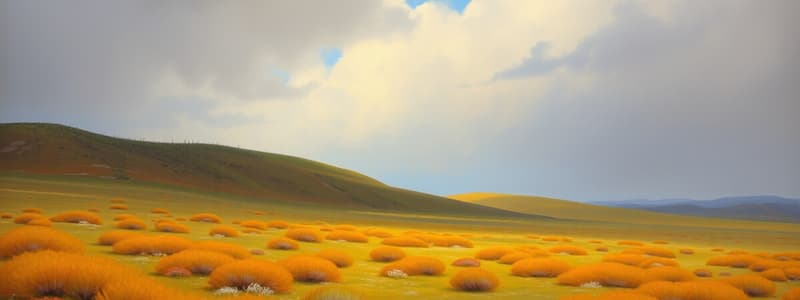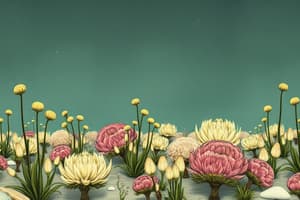Podcast
Questions and Answers
What primarily defines the vegetation in tundra regions?
What primarily defines the vegetation in tundra regions?
- It is a mix of herbaceous plants and lichen. (correct)
- Vegetation is limited to shrubs only.
- Trees dominate the landscape.
- Only grass species are prevalent.
What is a key feature of permafrost in tundra ecosystems?
What is a key feature of permafrost in tundra ecosystems?
- It restricts the growth of plant roots. (correct)
- It enhances the growth of plant roots.
- It allows for deep soil penetration.
- It provides a moisture-rich environment.
Which statement about aquatic biomes is true?
Which statement about aquatic biomes is true?
- Aquatic biomes show significant latitudinal variation.
- Freshwater biomes have salt concentrations greater than 3%.
- The largest aquatic biome is composed of freshwater lakes.
- Marine biomes consist of approximately 75% saltwater. (correct)
How does precipitation differ between arctic tundra and alpine tundra?
How does precipitation differ between arctic tundra and alpine tundra?
What impact does settlement have on tundra regions?
What impact does settlement have on tundra regions?
What term describes the influx of new individuals from other areas into a population?
What term describes the influx of new individuals from other areas into a population?
Which dispersion pattern describes individuals aggregating in patches?
Which dispersion pattern describes individuals aggregating in patches?
What is the focus of demography as a field of study?
What is the focus of demography as a field of study?
What does a life table represent?
What does a life table represent?
Which type of survivorship curve indicates a relatively constant death rate?
Which type of survivorship curve indicates a relatively constant death rate?
What is emigration in the context of population dynamics?
What is emigration in the context of population dynamics?
What primarily influences the pattern of uniform dispersion?
What primarily influences the pattern of uniform dispersion?
Which factor is primarily examined by demographers?
Which factor is primarily examined by demographers?
What is the current estimated global human population as mentioned?
What is the current estimated global human population as mentioned?
What is the projected human population by 2025?
What is the projected human population by 2025?
What trend is observed in global human population growth?
What trend is observed in global human population growth?
According to new U.N. estimates, what is the predicted human population by 2050?
According to new U.N. estimates, what is the predicted human population by 2050?
What is expected to happen to the human population after 2030, according to the model presented?
What is expected to happen to the human population after 2030, according to the model presented?
What annual percent increase in the global human population was recorded in 2014?
What annual percent increase in the global human population was recorded in 2014?
What general trend does the graph depicting annual percent increase show from 1950 to 2050?
What general trend does the graph depicting annual percent increase show from 1950 to 2050?
What will likely happen to global food production as the resources are depleted?
What will likely happen to global food production as the resources are depleted?
Which country represents rapid population growth?
Which country represents rapid population growth?
What is the predicted peak human population by about 2050?
What is the predicted peak human population by about 2050?
What does technology contribute to in terms of population dynamics?
What does technology contribute to in terms of population dynamics?
Which country's population structure reflects no growth?
Which country's population structure reflects no growth?
What is the primary factor that prevents indefinite population growth?
What is the primary factor that prevents indefinite population growth?
Which age group may represent the largest demographic segment in a population with rapid growth?
Which age group may represent the largest demographic segment in a population with rapid growth?
What societal aspect is intertwined with population growth, as indicated in the content?
What societal aspect is intertwined with population growth, as indicated in the content?
Which country is associated with a population structure characterized by slow growth?
Which country is associated with a population structure characterized by slow growth?
What best defines a species' ecological niche?
What best defines a species' ecological niche?
How does the fundamental niche of a species differ from its realized niche?
How does the fundamental niche of a species differ from its realized niche?
What is resource partitioning?
What is resource partitioning?
Which statement correctly describes predation?
Which statement correctly describes predation?
Which of the following adaptations might be found in predators?
Which of the following adaptations might be found in predators?
When does a species' realized niche differ from its fundamental niche?
When does a species' realized niche differ from its fundamental niche?
What occurs as a result of resource partitioning among species?
What occurs as a result of resource partitioning among species?
Which of the following best describes the outcome of strong interspecific competition?
Which of the following best describes the outcome of strong interspecific competition?
Flashcards are hidden until you start studying
Study Notes
Tundra Ecology
- Tundra exists in large areas of the Arctic and at high mountain peaks, termed alpine tundra.
- Arctic tundra receives low precipitation; alpine tundra experiences higher amounts.
- Winters can see temperatures below −30°C, while summer temperatures rarely exceed 10°C.
- Dominant vegetation includes herbaceous plants: mosses, grasses, forbs, dwarf shrubs, trees, and lichens.
- Permafrost inhibits root growth due to the permanently frozen layer beneath the soil.
- Key mammal species include musk oxen, caribou, reindeer, bears, wolves, and foxes.
- Many migratory birds nest during summer months, as human settlement remains sparse.
- Tundra regions are increasingly targeted for oil and mineral extraction activities.
Aquatic Biomes
- Aquatic biomes cover the majority of the Earth and are defined by their physical environments.
- Marine biomes contain an average salt concentration of ~3% and represent the largest biome, covering about 75% of the Earth.
- Freshwater biomes have salt concentrations below 0.1% and are connected to adjacent terrestrial ecosystems.
Population Ecology
- Population density results from the balance between immigration and emigration, as well as births and deaths.
- Immigration increases population size, while emigration decreases it.
- Births and immigration contribute to population growth, while deaths and emigration lead to declines.
- Patterns of dispersion include clumped, uniform, and random distributions.
- Demography analyzes population statistics like birth and death rates, providing insight into population dynamics.
Life Tables and Survivorship Curves
- Life tables summarize age-specific survival rates within a population.
- Survivorship curves offer a visual representation of population survival patterns, such as those seen in Belding's ground squirrels.
Human Population Dynamics
- The human population exceeds 6.4 billion and is projected to reach 7.3 to 8 billion by 2025.
- Recent predictions estimate a global population of 9.6 billion by 2050.
- As resources dwindle, projections indicate a possible decline in food production and population post-2030.
Population Age Structures
- Different countries exhibit varying population growth patterns: rapid growth in Afghanistan, slow growth in the U.S., and no growth in Italy.
- Population momentum in China highlights the implications of age structure on future growth rates.
Implications of Population Growth
- Computer models estimate human population will peak around 10.6 billion by 2050.
- Technological advancements have allowed for increased resource capacity, but indefinite growth is unsustainable.
Ecological Niches
- A species’ ecological niche encompasses its use of biotic and abiotic resources in its environment.
- The fundamental niche represents the potential habitat of a species, while the realized niche is the habitat occupied after competition.
- Resource partitioning enables the coexistence of similar species by differentiating their ecological niches.
Predation Dynamics
- Predation describes an interaction where one species (predator) kills and consumes another (prey), showcasing a (+/−) relationship.
- Predators may develop specialized adaptations such as claws, fangs, and toxins to improve their hunting efficiency.
Studying That Suits You
Use AI to generate personalized quizzes and flashcards to suit your learning preferences.




